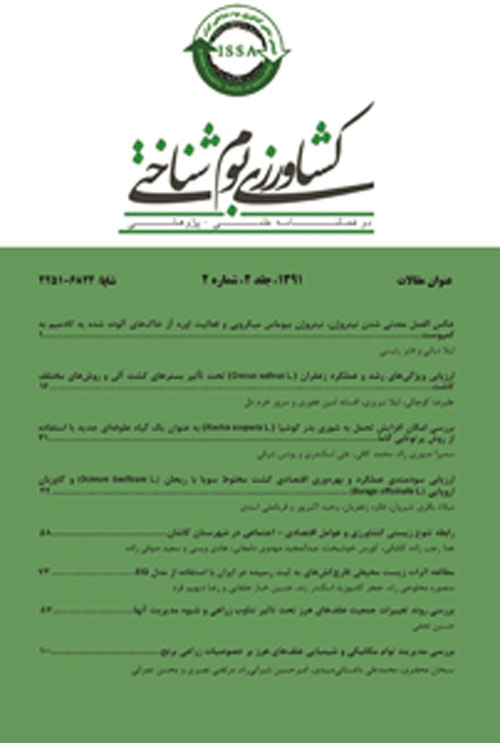The effect of nano-iron chelate fertilizer on ecomorphological characteristics of pearl millet- cowpea intercropping
Author(s):
Abstract:
Introduction
Applying modern technology such as nanotechnology to agricultural sciences is essential. Nanotechnology has many applications in enhancing the ability of plants to absorb nutrients (Mousavi and Rezaei, 2011). Cereals are highly important for their high dry matter production. They are, however, poor in protein content which shows their low quality and nutritive value. It is essential to use intercropping of cereals with legumes extensively to provide acceptable crop yield and quality (Ghanbari et al., 2007; Dahmarde, 2010). This study was conducted to evaluate the effects of spraying nano-iron chelate fertilizer on a pearl millet-cowpea intercropping.Materials And Methods
This experiment was conducted as a split randomized complete block design with three replications in 2015, at the research field of the Agricultural and Natural Resources of Bampour, Sistan and Baluchestan provinces. In this experiment, pearl millet is considered a main crop. Nano-chelated iron was sprayed at concentrations of 0%, 1%, 2% and 3% in two stages comprising main-plots and 5 cropping systems including: pearl millet sole culture, cowpea sole culture, 100% millet 20% cowpea, 100% millet 40% cowpea and 100% millet 60% cowpea. Evaluated parameters included plant height, leaf number per plant, one-thousand grain weight, grain yield, biological yield, harvest index and Land Equivalent Ratio (LER).Results And Discussion
Results indicated that the interaction of nano-iron chelate and cropping systems was significant on all studied traits (except leaf number of pearl millet and cowpea and LER). In addition, the effects of nano-iron chelate was significant on all studied traits, with the exception of pearl millet plant height. Mean comparison revealed that plants in a pearl millet sole culture that were sprayed with a nano-iron concentrate of 3% increased grain yield by 13 percent compared with non-sprayed plants of 100% millet% cowpea. Among fertilizer treatments, spraying with nano-iron at a concentration of 3% increased the grain yield of pearl millet by 46 percent in comparison with those not sprayed. Spraying a cowpea sole culture with nano-iron at a concentration of 3% increased yield by 11%, compared with unsprayed 100% millet% cowpea. In addition, spraying with nano-iron at a concentration of 3% increased cowpea grain yield by 43% over the unsprayed. The maximum LER (1.8) was obtained at 100% millet 60% cowpea.Conclusion
The results of the experiment confirmed that nano-iron chelate fertilizer was effective on intercroppings of pearl millet and cowpea. Plants sprayed with concentrations of 3% had the greatest morphological characteristics and yield of both crops. Low amounts of iron in the soil along with a nano-iron chelate treatment led to increased grain yield. Due to inter-plant completion, the greatest morphological characteristics of both plant species was obtained when sown in a sole culture.Keywords:
Language:
Persian
Published:
Journal of Agroecology, Volume:7 Issue: 1, 2017
Page:
96
magiran.com/p1733924
دانلود و مطالعه متن این مقاله با یکی از روشهای زیر امکان پذیر است:
اشتراک شخصی
با عضویت و پرداخت آنلاین حق اشتراک یکساله به مبلغ 1,390,000ريال میتوانید 70 عنوان مطلب دانلود کنید!
اشتراک سازمانی
به کتابخانه دانشگاه یا محل کار خود پیشنهاد کنید تا اشتراک سازمانی این پایگاه را برای دسترسی نامحدود همه کاربران به متن مطالب تهیه نمایند!
توجه!
- حق عضویت دریافتی صرف حمایت از نشریات عضو و نگهداری، تکمیل و توسعه مگیران میشود.
- پرداخت حق اشتراک و دانلود مقالات اجازه بازنشر آن در سایر رسانههای چاپی و دیجیتال را به کاربر نمیدهد.
In order to view content subscription is required
Personal subscription
Subscribe magiran.com for 70 € euros via PayPal and download 70 articles during a year.
Organization subscription
Please contact us to subscribe your university or library for unlimited access!


